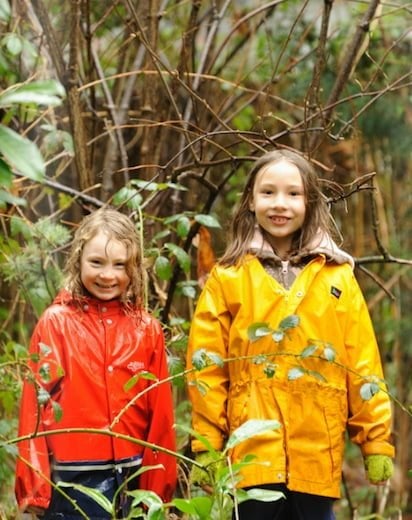Waldorf Education: A School Where the Fun Never Ends
Join us for a day in the life at a Waldorf School.
It’s a rainy winter morning at the Three Cedars Waldorf School in Bellevue, Washington. The second graders rush playfully across the school to their classroom.
The fun starts at the door
Raingear hung at their cubbies and now attired in comfy slippers, the children line up at the door where a tunnel of ever smaller hula hoops invites them to get in. At the other end Mr. Zabel, their teacher since First Grade, awaits them with a welcoming smile and greets them with a hearty handshake.
“Some children are still running into each other on the playground, and do not realize where their body ends. Controlling their body to prevent the hoops from falling makes them aware of body boundaries. Also, the hoops create a conscious threshold to classroom expectations, from playing outside to a quiet voice inside,” explains Mr. Zabel.
Once at their desks the children start the day modeling shapes in clay, form drawing or watercolor painting while they wait for all 13 classmates to get in.
Main Lesson Story
Everyone recites the morning verse together before going outside to jump rope. A few children are sitting on bouncy balls instead of chairs, and one on a one legged stool. The special sitting arrangements are assigned to different children each day. “Movement, song and rhythmical recitation warm up the children and get them ready to learn,” says Mr. Zabel.
The Main Lesson today is the story of Saint Martin of Tours. It was originally introduced in the fall when the children lit their way in the dark through the backwoods of the school in a “Lantern Walk.” A tradition in many European countries, the Lantern Walk celebrates how Saint Martin, a former Roman soldier, was carried by holy beings of light when he passed away. He had a saintly life of helping and healing that began when he split his cloak in two halves to share it with a beggar, who later appeared in a dream as the Lord.
“Multiplying by dividing is a secret Martin knew,” say the children in chorus. The story is used to teach the children math, as the cloak is divided in halves and then each piece is divided in halves again to get four. Children can continue dividing and counting how many pieces they have. Lessons on reading, writing, singing and playing music, drawing and painting, also tie in with the story. Curricular connections like these help the children in seeing the topic from different perspectives. Acting is also a part of the curriculum and the children are rehearsing a play based on the story, which they will present to the entire school community.
Knitting Fun Characters
After a healthy snack and recess, the children are back in the classroom for handwork class – a gnome knitting project. Mrs. Whithlatch , the handwork teacher, sets individualized goals for how many rows each child is expected to knit today. Last month they completed a stuffed knit kitty, to the amazement of many parents. “Knitting helps the developing brain make connections that help with math skills among other things,” says Mrs. Whithlatch, who was a biotech researcher before obtaining her Waldorf Teacher certification 10 years ago.
What is Eurythmy?
In Eurythmy class later that day, Ms. Foster teaches children this unique art form practiced in Waldorf schools.
“Eurythmy expresses the sounds of language and the elements of music in a visual way. By moving together in a group, the students develop an enhanced social awareness. This type of movement stimulates brain activity otherwise not awakened, and particularly supports the development of a greater flexibility in thinking,” says Ms. Foster, who was a successful touring musician before becoming a Waldorf teacher. “The children delight in discovering new ways to move together as a group,” she adds.
Woods Recess in Pairs
After lunch Mr. Zabel and the children put on their raingear and boots and head out for free play time in the woods. To make sure everyone will play, Mr. Zabel assigns a weekly partner to each child. Children must stay with their partner for the duration of recess, so they have to figure out how to play together even if they are not best friends.
This approach also encourages the children to get to know all their classmates and helps the most socially challenged make friends.
“Buenos Dias Senor Gandara!”
After recess the children greet Mr. Gandara, the Spanish teacher. Today they are learning about clothing and the seasons and they are enjoying being able to dialogue with the teacher and within the group.
The children also have a Japanese class once a week with Mrs. Tokura, and last month they learned a song in Swedish for the traditional Santa Lucia procession. Mr. Zabel also teaches them poems and rhymes in German, his native language, and they will be exposed to Hebrew in later years as they participate in Jewish celebrations.
“Among the many benefits of learning a second language during the elementary years, perhaps none is more important than the exposure to different cultures, which enables the student to understand diversity,” says Mr. Gandara.
Chores At The End of the Day
Before the children go home each day they are assigned a chore. Three children go outside to dispose the garbage, recycling and compost, three others sweep the classroom floor while a boy sweeps outside and a girl checks the cubbies. Two children dust side tables and chests and two others go outside to clap the chalk erasers. When all chores are completed each child shakes hands with Mr. Zabel, goes through the hoops tunnel and heads out to await their ride home.
Three Cedars children may not realize that the fun they are having is actually learning and they are eager to come back for more the next day.

